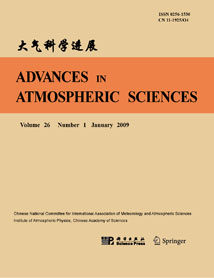| [1] |
Li Xin, Hu Fei, Pu Yifen, M.H.Al-Jiboori, Hu Zhaoxia, Hong Zhongxiang,
2002: Identification of Coherent Structures of Turbulence at the Atmospheric Surface Layer, ADVANCES IN ATMOSPHERIC SCIENCES, 19, 687-698.
doi: 10.1007/s00376-002-0008-x
|
| [2] |
Yu SHI, Qingcun ZENG, Fei HU, Weichen DING, Zhe ZHANG, Kang ZHANG, Lei LIU,
2023: Different Turbulent Regimes and Vertical Turbulence Structures of the Urban Nocturnal Stable Boundary Layer, ADVANCES IN ATMOSPHERIC SCIENCES, 40, 1089-1103.
doi: 10.1007/s00376-022-2198-8
|
| [3] |
Yawei QU, Tijian WANG, Yanfeng CAI, Shekou WANG, Pulong CHEN, Shu LI, Mengmeng LI, Cheng YUAN, Jing WANG, Shaocai XU,
2018: Influence of Atmospheric Particulate Matter on Ozone in Nanjing, China: Observational Study and Mechanistic Analysis, ADVANCES IN ATMOSPHERIC SCIENCES, 35, 1381-1395.
doi: 10.1007/s00376-018-8027-4
|
| [4] |
LIU Hongnian, JIANG Weimei, HUANG Jian, MAO Weikang,
2011: Characteristics of the Boundary Layer Structure of Sea Fog on the Coast of Southern China, ADVANCES IN ATMOSPHERIC SCIENCES, 28, 1377-1389.
doi: 10.1007/s00376-011-0191-8
|
| [5] |
CHENG Xue-Ling, HUANG Jian, WU Lin, ZENG Qing-Cun,
2015: Structures and Characteristics of the Windy Atmospheric Boundary Layer in the South China Sea Region during Cold Surges, ADVANCES IN ATMOSPHERIC SCIENCES, 32, 772-782.
doi: 10.1007/s00376-014-4228-7
|
| [6] |
Paul D. WILLIAMS,
2017: Increased Light, Moderate, and Severe Clear-Air Turbulence in Response to Climate Change, ADVANCES IN ATMOSPHERIC SCIENCES, 34, 576-586.
doi: 10.1007/s00376-017-6268-2
|
| [7] |
Peter SHERIDAN, Anlun XU, Jian LI, Kalli FURTADO,
2023: Use of Targeted Orographic Smoothing in Very High Resolution Simulations of a Downslope Windstorm and Rotor in a Sub-tropical Highland Location, ADVANCES IN ATMOSPHERIC SCIENCES, 40, 2043-2062.
doi: 10.1007/s00376-023-2298-0
|
| [8] |
Yang HE, Xiaoqian ZHU, Zheng SHENG, Wei GE, Xiaoran ZHAO, Mingyuan HE,
2022: Atmospheric Disturbance Characteristics in the Lower-middle Stratosphere Inferred from Observations by the Round-Trip Intelligent Sounding System (RTISS) in China, ADVANCES IN ATMOSPHERIC SCIENCES, 39, 131-144.
doi: 10.1007/s00376-021-1110-2
|
| [9] |
P. VINAY KUMAR, Gopa DUTTA, M.V. RATNAM, E. KRISHNA, B. BAPIRAJU, B. Venkateswara RAO, Salauddin MOHAMMAD,
2016: Impact of Cyclone Nilam on Tropical Lower Atmospheric Dynamics, ADVANCES IN ATMOSPHERIC SCIENCES, 33, 955-968.
doi: 10.1007/s00376-016-5285-x
|
| [10] |
LI Wanli, LU Shihua, FU Shenming, MENG Xianhong, H. C. NNAMCHI,
2011: Numerical Simulation of Fluxes Generated by Inhomogeneities of the Underlying Surface over the Jinta Oasisin Northwestern China, ADVANCES IN ATMOSPHERIC SCIENCES, 28, 887-906.
doi: 10.1007/s00376-010-0041-0
|
| [11] |
HU Yongyun,
2007: Probability Distribution Function of a Forced Passive Tracer in the Lower Stratosphere, ADVANCES IN ATMOSPHERIC SCIENCES, 24, 163-180.
doi: 10.1007/s00376-007-0163-1
|
| [12] |
Liu Shikuo, Peng Weihong, Huang Feng, Chi Dongyan,
2002: Effects of Turbulent Dispersion on the Wind Speed Profile in the Surface Layer, ADVANCES IN ATMOSPHERIC SCIENCES, 19, 794-806.
doi: 10.1007/s00376-002-0045-5
|
| [13] |
Zhida HUANG, Hailong LIU, Pengfei LIN, Jianyu HU,
2017: Influence of Island Chains on the Kuroshio Intrusion in the Luzon Strait, ADVANCES IN ATMOSPHERIC SCIENCES, 34, 397-410.
doi: 10.1007/s00376-016-6159-y
|
| [14] |
Xiaoyu REN, Yi LIU, Zhaonan CAI, Yuli ZHANG,
2022: Observations of Dynamic Turbulence in the Lower Stratosphere over Inner Mongolia Using a High-resolution Balloon Sensor Constant Temperature Anemometer, ADVANCES IN ATMOSPHERIC SCIENCES, 39, 519-528.
doi: 10.1007/s00376-021-1233-5
|
| [15] |
Zhida HUANG, Hailong LIU, Jianyu HU, Pengfei LIN,
2016: A Double-Index Method to Classify Kuroshio Intrusion Paths in the Luzon Strait, ADVANCES IN ATMOSPHERIC SCIENCES, 33, 715-729.
doi: 10.1007/s00376-015-5171-y
|
| [16] |
ZHU Bin, WANG Honglei, SHEN Lijuan, KANG Hanqing, YU Xingna,
2013: Aerosol Spectra and New Particle Formation Observed in Various Seasons in Nanjing, ADVANCES IN ATMOSPHERIC SCIENCES, 30, 1632-1644.
doi: 10.1007/s00376-013-2202-4
|
| [17] |
ZHOU Yushu, DENG Guo, LEI Ting, JU Jianhua,
2005: The Thermodynamic and Dynamical Features of Double Front Structures During 21-31 July 1998 in China, ADVANCES IN ATMOSPHERIC SCIENCES, 22, 924-935.
doi: 10.1007/BF02918691
|
| [18] |
Liu Shida, Liu Shikuo, Xin Guojun, Liang Fuming,
1994: The Theoretical Model of Atmospheric Turbulence Spectrum in Surface Layer, ADVANCES IN ATMOSPHERIC SCIENCES, 11, 408-414.
doi: 10.1007/BF02658160
|
| [19] |
Hao LUO, Yong HAN, Chunsong LU, Jun YANG, Yonghua WU,
2019: Characteristics of Surface Solar Radiation under Different Air Pollution Conditions over Nanjing, China: Observation and Simulation, ADVANCES IN ATMOSPHERIC SCIENCES, 36, 1047-1059.
doi: 10.1007/s00376-019-9010-4
|
| [20] |
Huang Yao, Jiang Jingyan, Zong Lianggang, Ronald L. Sass, Frank M. Fisher,
2001: Comparison of Field Measurements of CH4 Emission from Rice Cultivation in Nanjing, China and in Texas, USA, ADVANCES IN ATMOSPHERIC SCIENCES, 18, 1121-1130.
doi: 10.1007/s00376-001-0027-z
|















 AAS Website
AAS Website 
 AAS WeChat
AAS WeChat 
 DownLoad:
DownLoad: